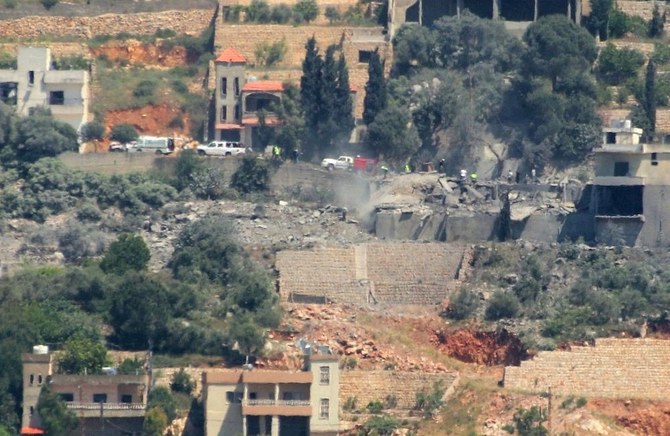
- ARAB NEWS
- 15 Jul 2025

BEIRUT: The Israeli army launched more than 20 airstrikes on Lebanese border towns on Wednesday, resulting in deaths and injuries.
Alarms blared in the settlements of Adamit, Goren, Eilon, and Arab Al-Aramsheh in Western Galilee and Israeli media reported: “Hezbollah is leading a major attack from southern Lebanon using missiles and drones, and sirens are continuously sounding.”
Israeli news sites said: “Injuries occurred among the Israelis in the north due to missile strikes carried out by Hezbollah on Avivim, and the situation is difficult. Seven soldiers in the Al-Malikiyah site were hit, several killed and others injured, in a combined operation involving a missile salvo and suicide drone attacks. Hezbollah’s attacks also targeted the settlement of Kiryat Shmona.”
One outlet said a reservist soldier had been killed, while others reported power outages in Avivim and Dovev as a result of Hezbollah shelling.
Israeli army spokesman Avichay Adraee confirmed: “Airstrikes were launched at Hezbollah-affiliated targets in six areas in southern Lebanon, and Israeli warplanes raided the party’s military buildings in Kfarkela, Aita Al-Shaab, Khiam, and Maroun Al-Ras.”
Ten airstrikes hit the forest area stretching from the outskirts of Aita Al-Shaab to those of Ramyah within a few hours. The raids continued on the towns of Yaroun, Jabal Blat, Kfarkela, the outskirts of Rihan, Aaramta and Khiam.
One house in Khiam was completely destroyed. Paramedics working to remove the rubble found three Hezbollah members had been killed and another injured.
Aitaroun and Blida were hit with phosphorus bombs, which are banned internationally, while artillery shelling was recorded on the outskirts of the towns of Naqoura, Halta, Kfarchouba and Jabal Blat.
Civil defense teams in the Kfarkela-Tal Nahas area worked to extinguish a fire caused by one of the airstrikes.
According to a security source, the Israeli military utilized “GBU bunker-buster bombs in the airstrikes on Kafr Kila, renowned for their effectiveness in penetrating fortified structures. These bombs, part of Israel’s arsenal since 2000, were reportedly replenished through intensified American shipments.”
In retaliation, Hezbollah launched operations against Israeli military sites, some with guided missiles, causing deaths and injuries among Israeli soldiers. Hezbollah said this was in response to enemy attacks on southern villages and civilian homes.
A building used by Israeli soldiers in the Metula settlement was targeted, along with two structures in the Shlomi settlement, one in Hanita, two in Avivim, and a building at the Al-Manara site.
Later, Hezbollah targeted Israeli soldiers at the Raheb site, causing direct damage. A statement from the organization said it simultaneously targeted and destroyed espionage equipment at the same location.
The source highlighted a significant uptick in military engagement between the Israeli army and Hezbollah over the past 48 hours, coinciding with Israel’s incursion into and seizure of the Rafah crossing.
Media reports said: “Hezbollah has resorted to unconventional weaponry against Israeli sites in response to Israel’s scorched-earth tactics along the border, making the area inhospitable due to extensive phosphorus contamination. The cleanup process, aiming to rid the region of the pollutants used by the Israeli military to devastate crops, groundwater and soil, is anticipated to span several years.”
Israeli positions adjacent to the Blue Line unleashed heavy machine gun fire on the outskirts of Rmeich and Ramyah, targeting water tanks and vital roads connecting border communities.
Hezbollah has tied a ceasefire along the southern front to a cessation of hostilities in the Gaza Strip.